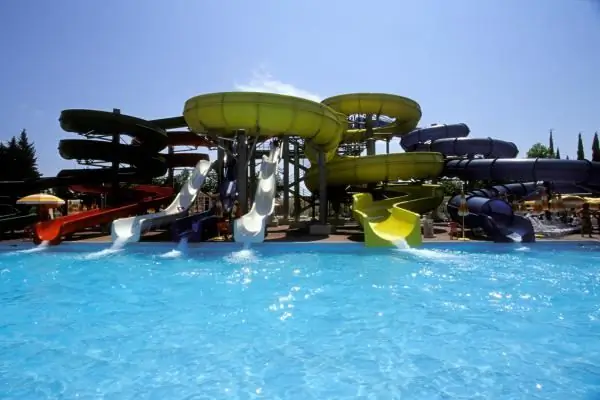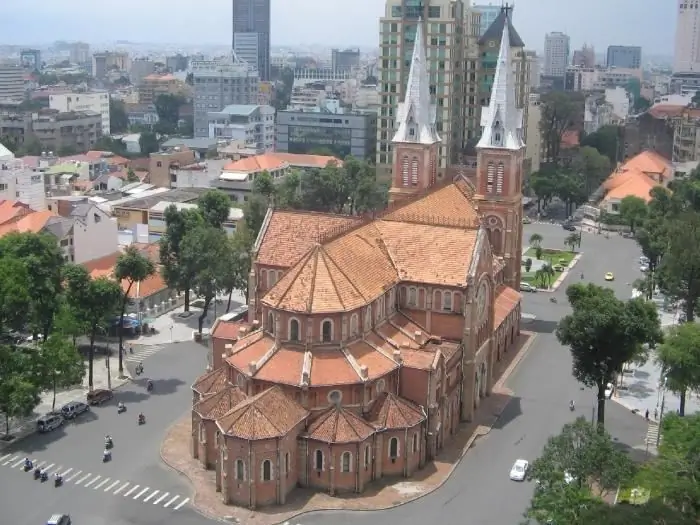- Author Harold Hamphrey [email protected].
- Public 2023-12-17 10:06.
- Last modified 2025-01-24 11:10.
Fabulous Italy, whose sights silently testify to a rich history, is of great interest to travelers. Charming Venice occupies a separate place among other cities of the country, and its architectural masterpieces are known all over the world.
Medieval monument Basilica di San Marco
Ancient San Marco is a cathedral in Venice, which is rightfully recognized as an outstanding monument of medieval art. The most beautiful building, which appeared in the 9th century, excites people's hearts, making them beat faster at the sight of the rarest example of Byzantine architecture in Europe. In 1987, the attraction was listed as a UNESCO World Heritage Site.

Residents of the city and foreign guests admire the ancient cathedral, which occupies an honorable place in the world's treasury of architectural works.
Saint Mark's Basilica in Piazza San Marco
The main religiousThe landmark of Venice is located in the Sestiere San Marco district, on the central square of the same name (Piazza San Marco), which is the hallmark of the city. Most tourists rush to get acquainted with the significant monuments of the country, to the famous San Marco in Venice (square).
The cathedral, whose history goes back several centuries, showed the power and greatness of the Venetian Republic. It was originally planned that the relics of St. Mark would be in the basilica, which in 829 were saved by Italian merchants from the desecration of Muslims and brought to the city on the water from Alexandria. According to legend, an angel came to the wandering apostle in a dream, announcing that after death he would find peace in Venice, and the merchants fulfilled his last will. When the shrine arrived in the city, the apostle received the status of its patron.
In 832, the first version of the cathedral appeared, which after 150 years was seriously destroyed by fire, but the remains of the saint were not affected. Later, the basilica was restored, and it again delighted the parishioners. Its original architectural appearance was quite ascetic.
Modern Cathedral of San Marco: description, history, exact address
The construction of the modern basilica, located at 328 San Marco, 30124 Venezia, began in 1063, and the building was consecrated at the end of the century. But for several centuries, the design of the fabulously beautiful temple of San Marco continued. The cathedral in Venice is an unusual attraction, because it was decorated by new generations of Venetians, who gave the appearance of a religious monument originality. And as a result, the attraction, which has become a place of pilgrimage for tourists, has turned into a museum of medieval art.

In the architectural appearance of the basilica, built of brick, there are elements of all kinds of styles. Marble of excellent quality, Greek bas-reliefs, Gothic capitals made up a wonderful whole ensemble. Thanks to the unique talent of the builders, there is no other masterpiece in the world that can compete in beauty and grandeur with San Marco.
The Cathedral in Venice, which went down in history as St. Mark's Basilica, was not officially considered a cathedral in the Middle Ages, and until the beginning of the 19th century, this status belonged to the city church of San Pietro di Castello.
The world masterpiece has become the center of urban social life: funerals of heroes, dedications of doges and other important ceremonies were held here, local residents went here in search of solace. It would not be an exaggeration to say that St. Mark's has become a religious and civic symbol of the city.
Relics brought from other countries
The cathedral in Venice on Piazza San Marco received its luxurious decoration between the 12th and 14th centuries. Decor elements belong to different times and were brought from other countries.
The shape of the cathedral is a Greek cross. The builders of Venice, economically and politically connected with Byzantium, adopted a lot from the masters of the powerful empire, including the design of the building topped with five domes resembling lanterns.
Facades of brick, which was not visible undermarble facing, decorate various relics brought to Venice. For example, some reliefs depicting hunting scenes were made in Byzantium, while carved pylons were brought from Syria.
Pala d'Oro, half a century in the making
The majestic San Marco (Cathedral in Venice) is famous throughout the world for its unique golden altar, recognized as the richest among those that have survived to this day. Miniature medallions made in the technique of cloisonne enamel are inserted into the upper part of the brightest element of the decoration of the temple. Expensive plates were taken out of Constantinople and are of the greatest value. Decorated with precious stones and gold, they are recognized as genuine works of art.

Iconostasis and ciborium
The altar part is separated by a Gothic iconostasis made of dark red marble brought from Constantinople from the central nave. It is crowned with a huge cross, and 14 sculptures are located on both sides of the barrier: 12 apostles, a statue of the Virgin Mary and the apostle Mark.
Here there is a special canopy over the throne, called "ciborium". Under it, the relics of the apostle are kept, transferred in the 30s of the 19th century from the crypt, in a marble sarcophagus, which is supported by four alabaster columns. Each of them is carved with reliefs depicting the Virgin Mary and Jesus Christ.
Crypt of the Basilica
In 1094, the relics of the apostle were placed in a crypt - a vaulted underground room designed to store shrines. Closed after 400 yearsfor visits. After the fall of the Venetian Republic, services began again in the crypt.

In its center there is a chapel, decorated with an openwork marble slab, under which the relics of the Apostle Mark were previously kept. In 1835 they were transferred to the main altar of the temple. Crete of the Cathedral of San Marco in Venice is of particular interest, since the surviving fragments of its architectural details, scientists date back to the time of the first cathedral.
What else is in the cathedral?
On the left side of the basilica is the altar of the Madonna, and next to it is the chapel of Isidore, where the sarcophagus with the remains of the saint is kept.
In the right wing is a baptistery for infant baptism. Its walls are decorated with marble, and the vaults are decorated with mosaic compositions. In the center of the room is a stone font with a bronze lid, and next to it, a tombstone was erected for the most revered Doge, Andrea Dandolo.
Luxury mosaic work
Mosaic paintings on the walls and the dome evoke a feeling of admiration. Many of them were made in the 13th century, and the earliest dates back to the 9th century.
Luxury compositions created by Italian masters who worked with glass and stone. It is believed that the Venetian artists were introduced to the art of mosaic by the Byzantines, who often visited the city.

Colorful mosaics on the walls of the basilica tell about the life of Jesus, tell about the patron saints of the city. In the center of the dome of the cathedral is locatedcomposition "The Ascension of Christ", and on the arches - episodes from the New Testament.
Marble brought from Constantinople
The beauty of the mosaics on the walls is amazingly combined with the rich ornamentation of the floor made of natural marble slabs.
I must say that this rock in the decoration of the cathedral appeared only in the XIII century. Marble columns from the temples of Constantinople became the prey of the Fourth Crusade. The builders used a new material, resulting in even greater splendor of the old St. Mark's Cathedral in Venice.

The Basilica of San Marco can be called a real museum of Venetian and Byzantine art, where priceless works of art are collected.
History of the quadriga
Above the entrance to the basilica is the famous four racing horses cast in bronze by Greek sculptors in the 4th century BC. The quadriga first served as a decoration of the triumphal arch in Rome, later for several centuries it flaunted on the gates of the hippodrome in Constantinople.
In the 13th century, the Venetian Doge Enrique Dandolo, who pulled the country out of the economic crisis, captured the capital of the Byzantine Empire, and as a trophy took out the sculpture, which was later, by order of Napoleon, sent to Paris, where it stood on the square for about 18 years Carousels. After the defeat of Bonaparte's army, the quadriga returned to Venice, and, by decision of the authorities, it was hoisted over the main entrance of the basilica. During war times, the sculpture with an amazing story was removed and hidden in shelters.

Today, the bronze horses of St. Mark's Cathedral in Venice are in the Basilica Museum, and the architectural monument is crowned by a beautifully executed copy that appeared in the 70s of the last century.
Atrium
Through the main entrance, visitors enter the atrium, the walls of which are decorated with marble and mosaics, which delighted the artist Surikov to the depths of his soul. The canvases tell about the events of the Old Testament, and each day of God's creation of the world is indicated by a snow-white angel. The tomb of the dogaressa (wife of the Doge) Felicity Michiel, decorated with stone lace, is also located here.
It is very easy to touch the collection of treasures of charming Venice and receive the blessing of St. Mark today - just go to the cathedral that keeps the relics of the apostle, which is a chronicle of religious and civil history.
Visitors to the basilica are presented with a unique biography of the most unusual city on the water, which has been attracting admiring travelers from different parts of our planet for several centuries.






